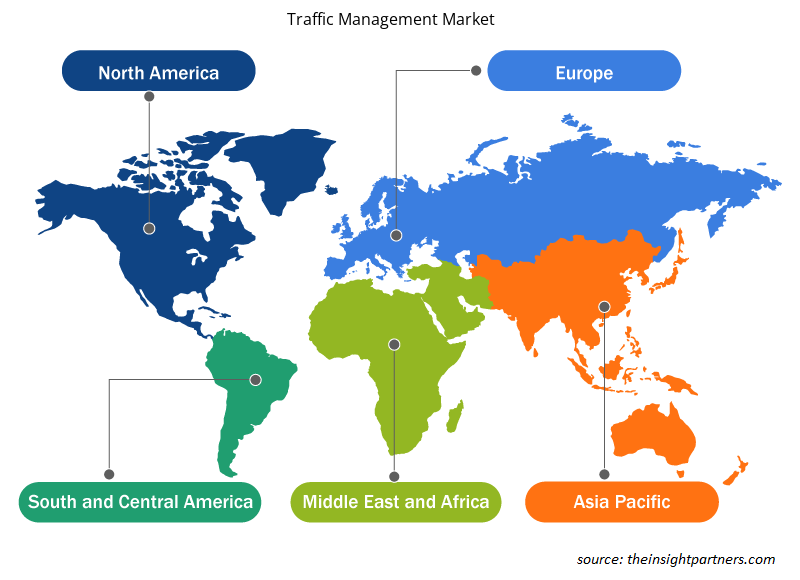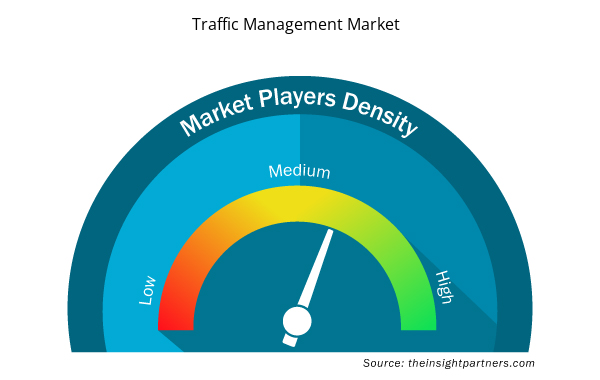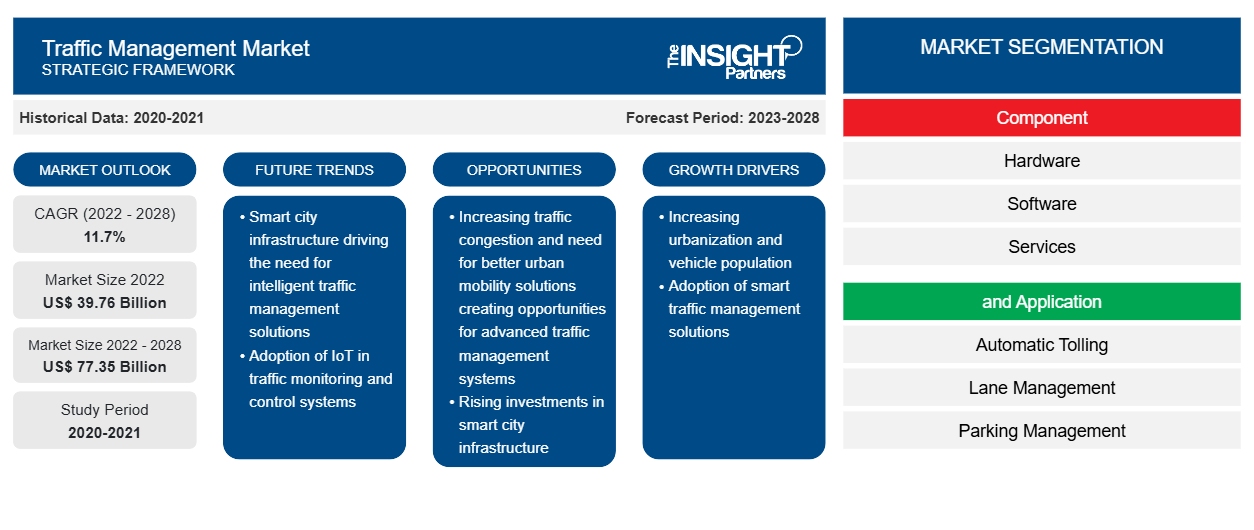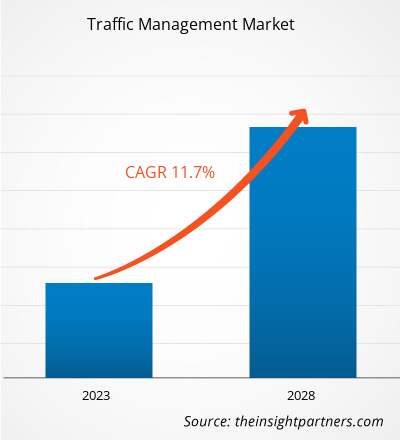交通管理市场规模预计将从 2022 年的 397.5674 亿美元增至 2028 年的 773.4644 亿美元;预计 2022 年至 2028 年的复合年增长率为 11.7%。
多年来,大多数国家都经历了剧烈的城市化,导致道路网络复杂,交通拥堵严重。城市人口的增加,加上私家车拥有量的增加,导致道路上的车辆数量增加。印度孟买的人口从 2011 年的 1850 万增加到 2020 年的 2040 万,而私家车的数量在此期间几乎翻了一番。由于这些因素,以及为了补救这些因素,交通管理市场预计将增长。此外,Uber、Grab、Ola 和 Lyft 等出租车聚合商提供的叫车服务也在快速增长。此类服务已经取代了公共交通系统,导致道路上的车辆数量激增。这些因素迫使政府当局向交通管理市场参与者寻求有效的解决方案。通过强大的交通管理系统(包括软件、传感器、摄像头和显示板),可以有效减少交通拥堵。这些系统可以安装在现有道路上,而无需进行基础设施改造。同样,车道管理系统可以根据每个时间点的交通率,通过开放或关闭车道来有效地管理交通流量。考虑到交通管理系统提供的优势,快速的城市化速度预计将大力推动交通管理市场规模。
COVID-19 疫情对交通管理市场增长的影响
2020 年,COVID-19 疫情扰乱了汽车、制造、能源和电力、航空航天和国防、建筑等垂直行业。COVID 患者数量的持续增长迫使美国和其他国家政府当局在 2020 年前三个季度实施严格的封锁。这导致所有国家的交通运输量大幅下降。实施贸易禁令、旅行限制和劳动力限制等遏制措施影响了各种企业的制造、供应和销售活动,包括提供交通管理硬件、软件和服务的公司。由于工厂暂时关闭和产量低,制造业遭受了严重损失,这也阻碍了交通管理硬件系统的生产。在美国,联邦政府和州政府更加专注于应对疫情;因此,交通管理硬件和软件的安装暂时搁置。欧洲交通管理行业因基础设施项目支出减少约 20% 而受到严重打击,导致多个智慧城市和智慧道路项目推迟和中止。半导体价格上涨和供应链中断进一步加剧了这种情况。不过,交通管理市场在 2020 年第四季度开始出现正增长。
定制此报告以满足您的需求
您可以免费定制任何报告,包括本报告的部分内容、国家级分析、Excel 数据包,以及为初创企业和大学提供优惠和折扣
- 获取此报告的关键市场趋势。这个免费样品将包括数据分析,从市场趋势到估计和预测。
市场洞察 – 交通管理市场
全球联网设备数量正在激增,许多国家正在投资建设智能城市。智能城市是技术先进的城市地区,采用各种传感器和电子方法收集数据并利用数据改善当地环境。智能城市的设计具有长期的交通管理计划,通过优化交通和物流并减少拥堵。因此,除了智能城市,各国也在投资建设智能道路,以提供更安全的车辆通勤。在智能道路上,不同类型的传感器和硬件收集用于监控交通的多变量数据。这些数据还可以与道路上行驶的车辆共享,让驾驶员和通勤者做出明智的决定。因此,智能城市和智能道路的日益普及有望扩大交通管理市场规模。
基于组件的洞察
交通管理市场根据组件、应用和地理位置进行细分。按组件划分,市场分为硬件、软件和服务。硬件市场进一步细分为摄像头、显示板和传感器;此外,软件市场分为云和本地。不同的政府机构一直在投资升级其交通管理硬件。城市化进程的加快和汽车保有量的增加给城市道路带来了负担。因此,当局依靠现代摄像头更好地维护交通流量并确保安全。自动车牌识别 (ANPR) 摄像头越来越多地用于识别违规者或在事故调查期间定位车辆。它们通常与激光传感器配对,以确定车辆的速度。
根据应用,交通管理市场分为自动收费、车道管理、停车管理、监控、交通信号管理等。根据地域,市场主要分为北美、欧洲、亚太地区 (APAC)、中东和非洲 (MEA) 和南美 (SAM)。IBM 公司、思科系统公司、西门子股份公司、杭州海康威视数字技术有限公司和大华技术有限公司是主要的交通管理市场参与者。
交通管理市场区域洞察
Insight Partners 的分析师已详细解释了预测期内影响交通管理市场的区域趋势和因素。本节还讨论了北美、欧洲、亚太地区、中东和非洲以及南美和中美洲的交通管理市场细分和地理位置。

- 获取交通管理市场的区域特定数据
交通管理市场报告范围
| 报告属性 | 细节 |
|---|---|
| 2022 年市场规模 | 397.6亿美元 |
| 2028 年市场规模 | 773.5亿美元 |
| 全球复合年增长率(2022 - 2028) | 11.7% |
| 史料 | 2020-2021 |
| 预测期 | 2023-2028 |
| 涵盖的领域 | 按组件
|
| 覆盖地区和国家 | 北美
|
| 市场领导者和主要公司简介 |
|
交通管理市场参与者密度:了解其对业务动态的影响
交通管理市场正在快速增长,这得益于终端用户需求的不断增长,而这些需求又源于消费者偏好的不断变化、技术进步以及对产品优势的认识不断提高等因素。随着需求的增加,企业正在扩大其产品范围,进行创新以满足消费者的需求,并利用新兴趋势,从而进一步推动市场增长。
市场参与者密度是指在特定市场或行业内运营的企业或公司的分布情况。它表明在给定市场空间中,相对于其规模或总市场价值,有多少竞争对手(市场参与者)存在。
在交通管理市场运营的主要公司有:
- 安讯士通讯公司
- 思科系统公司
- 立方公司
- 大华技术股份有限公司
- 杭州海康威视数字技术有限公司
免责声明:上面列出的公司没有按照任何特定顺序排列。

- 获取交通管理市场顶级关键参与者概览
交通管理市场参与者主要致力于开发先进、高效的产品。
- 2021年,大华股份宣布开发全面的智慧交通管理解决方案,该解决方案通过将视频监控与AI、ANPR、图像融合、AR和其他尖端技术相结合而开发,以满足现代交通执法部门的多样化需求。
- 2021 年,专注于摄像头的物联网解决方案提供商海康威视推出了 All-Rounder ITS 摄像头,这是其最新的交通产品,旨在改善道路安全和交通流量。该摄像头集多种功能于一身,包括速度检测、交通违规检测、自动车牌识别和车辆属性分析。
- 历史分析(2 年)、基准年、预测(7 年)及复合年增长率
- PEST 和 SWOT 分析
- 市场规模价值/数量 - 全球、区域、国家
- 行业和竞争格局
- Excel 数据集


- Microplate Reader Market
- Dairy Flavors Market
- Third Party Logistics Market
- Lyophilization Services for Biopharmaceuticals Market
- Integrated Platform Management System Market
- Data Annotation Tools Market
- Equipment Rental Software Market
- Dried Blueberry Market
- Semiconductor Metrology and Inspection Market
- Intraoperative Neuromonitoring Market

Report Coverage
Revenue forecast, Company Analysis, Industry landscape, Growth factors, and Trends

Segment Covered
This text is related
to segments covered.

Regional Scope
North America, Europe, Asia Pacific, Middle East & Africa, South & Central America

Country Scope
This text is related
to country scope.
常见问题
The traffic management market is expected to reach US$ 77,346.44 million by 2028.
The hardware segment led the traffic management market with a significant share in 2021. It is further expected to dominate the market share over the forecast period. However, software segment is expected to be the fastest growing.
India, China and Italy are expected to register high growth rates during the forecast period.
The US held the largest market share in 2021, followed by Germany.
Asia Pacific is the fastest growing regional market, followed by Europe.
The key players, holding majority shares, in traffic management market includes IBM Corporation; Cisco Systems, Inc.; Siemens AG; Hangzhou Hikvision Digital Technology Co., Ltd.; and Dahua Technology Co., Ltd.
Artificial Intelligence (AI) and Machine Learning (ML) are expected to play a crucial role in the future of the traffic management market. The application of AI and ML in traffic management is still quite nascent, and most countries are yet to adopt the same. However that scenario is changing fast, primarily due to the increasing number of connected cars.
Traffic management market is being driven by the rising urbanization, increasing congestion and growing investment in infrastructure development. Traffic management systems can be installed on an existing road without the requirements of infrastructural modification and thus can greatly aid in reducing congestion.
The global traffic management market was estimated to be USD 39,756.74 Million in 2021, and is expected to grow at a CAGR of 11.7%, during the forecast period 2022 - 2028.
The incremental growth, expected to be recorded for the traffic management market during the forecast period, is US$ 37,589.70 million.
Trends and growth analysis reports related to Technology, Media and Telecommunications : READ MORE..
The List of Companies - Traffic Management Market
- Axis Communications AB
- Cisco Systems, Inc.
- Cubic Corporation
- Dahua Technology Co., Ltd.
- Hangzhou Hikvision Digital Technology Co., Ltd.
- IBM Corporation
- SGS SA
- Siemens AG
- SNC-Lavalin Group
- Teledyne FLIR LLC
The Insight Partners performs research in 4 major stages: Data Collection & Secondary Research, Primary Research, Data Analysis and Data Triangulation & Final Review.
- Data Collection and Secondary Research:
As a market research and consulting firm operating from a decade, we have published and advised several client across the globe. First step for any study will start with an assessment of currently available data and insights from existing reports. Further, historical and current market information is collected from Investor Presentations, Annual Reports, SEC Filings, etc., and other information related to company’s performance and market positioning are gathered from Paid Databases (Factiva, Hoovers, and Reuters) and various other publications available in public domain.
Several associations trade associates, technical forums, institutes, societies and organization are accessed to gain technical as well as market related insights through their publications such as research papers, blogs and press releases related to the studies are referred to get cues about the market. Further, white papers, journals, magazines, and other news articles published in last 3 years are scrutinized and analyzed to understand the current market trends.
- Primary Research:
The primarily interview analysis comprise of data obtained from industry participants interview and answers to survey questions gathered by in-house primary team.
For primary research, interviews are conducted with industry experts/CEOs/Marketing Managers/VPs/Subject Matter Experts from both demand and supply side to get a 360-degree view of the market. The primary team conducts several interviews based on the complexity of the markets to understand the various market trends and dynamics which makes research more credible and precise.
A typical research interview fulfils the following functions:
- Provides first-hand information on the market size, market trends, growth trends, competitive landscape, and outlook
- Validates and strengthens in-house secondary research findings
- Develops the analysis team’s expertise and market understanding
Primary research involves email interactions and telephone interviews for each market, category, segment, and sub-segment across geographies. The participants who typically take part in such a process include, but are not limited to:
- Industry participants: VPs, business development managers, market intelligence managers and national sales managers
- Outside experts: Valuation experts, research analysts and key opinion leaders specializing in the electronics and semiconductor industry.
Below is the breakup of our primary respondents by company, designation, and region:

Once we receive the confirmation from primary research sources or primary respondents, we finalize the base year market estimation and forecast the data as per the macroeconomic and microeconomic factors assessed during data collection.
- Data Analysis:
Once data is validated through both secondary as well as primary respondents, we finalize the market estimations by hypothesis formulation and factor analysis at regional and country level.
- Macro-Economic Factor Analysis:
We analyse macroeconomic indicators such the gross domestic product (GDP), increase in the demand for goods and services across industries, technological advancement, regional economic growth, governmental policies, the influence of COVID-19, PEST analysis, and other aspects. This analysis aids in setting benchmarks for various nations/regions and approximating market splits. Additionally, the general trend of the aforementioned components aid in determining the market's development possibilities.
- Country Level Data:
Various factors that are especially aligned to the country are taken into account to determine the market size for a certain area and country, including the presence of vendors, such as headquarters and offices, the country's GDP, demand patterns, and industry growth. To comprehend the market dynamics for the nation, a number of growth variables, inhibitors, application areas, and current market trends are researched. The aforementioned elements aid in determining the country's overall market's growth potential.
- Company Profile:
The “Table of Contents” is formulated by listing and analyzing more than 25 - 30 companies operating in the market ecosystem across geographies. However, we profile only 10 companies as a standard practice in our syndicate reports. These 10 companies comprise leading, emerging, and regional players. Nonetheless, our analysis is not restricted to the 10 listed companies, we also analyze other companies present in the market to develop a holistic view and understand the prevailing trends. The “Company Profiles” section in the report covers key facts, business description, products & services, financial information, SWOT analysis, and key developments. The financial information presented is extracted from the annual reports and official documents of the publicly listed companies. Upon collecting the information for the sections of respective companies, we verify them via various primary sources and then compile the data in respective company profiles. The company level information helps us in deriving the base number as well as in forecasting the market size.
- Developing Base Number:
Aggregation of sales statistics (2020-2022) and macro-economic factor, and other secondary and primary research insights are utilized to arrive at base number and related market shares for 2022. The data gaps are identified in this step and relevant market data is analyzed, collected from paid primary interviews or databases. On finalizing the base year market size, forecasts are developed on the basis of macro-economic, industry and market growth factors and company level analysis.
- Data Triangulation and Final Review:
The market findings and base year market size calculations are validated from supply as well as demand side. Demand side validations are based on macro-economic factor analysis and benchmarks for respective regions and countries. In case of supply side validations, revenues of major companies are estimated (in case not available) based on industry benchmark, approximate number of employees, product portfolio, and primary interviews revenues are gathered. Further revenue from target product/service segment is assessed to avoid overshooting of market statistics. In case of heavy deviations between supply and demand side values, all thes steps are repeated to achieve synchronization.
We follow an iterative model, wherein we share our research findings with Subject Matter Experts (SME’s) and Key Opinion Leaders (KOLs) until consensus view of the market is not formulated – this model negates any drastic deviation in the opinions of experts. Only validated and universally acceptable research findings are quoted in our reports.
We have important check points that we use to validate our research findings – which we call – data triangulation, where we validate the information, we generate from secondary sources with primary interviews and then we re-validate with our internal data bases and Subject matter experts. This comprehensive model enables us to deliver high quality, reliable data in shortest possible time.


 获取此报告的免费样本
获取此报告的免费样本